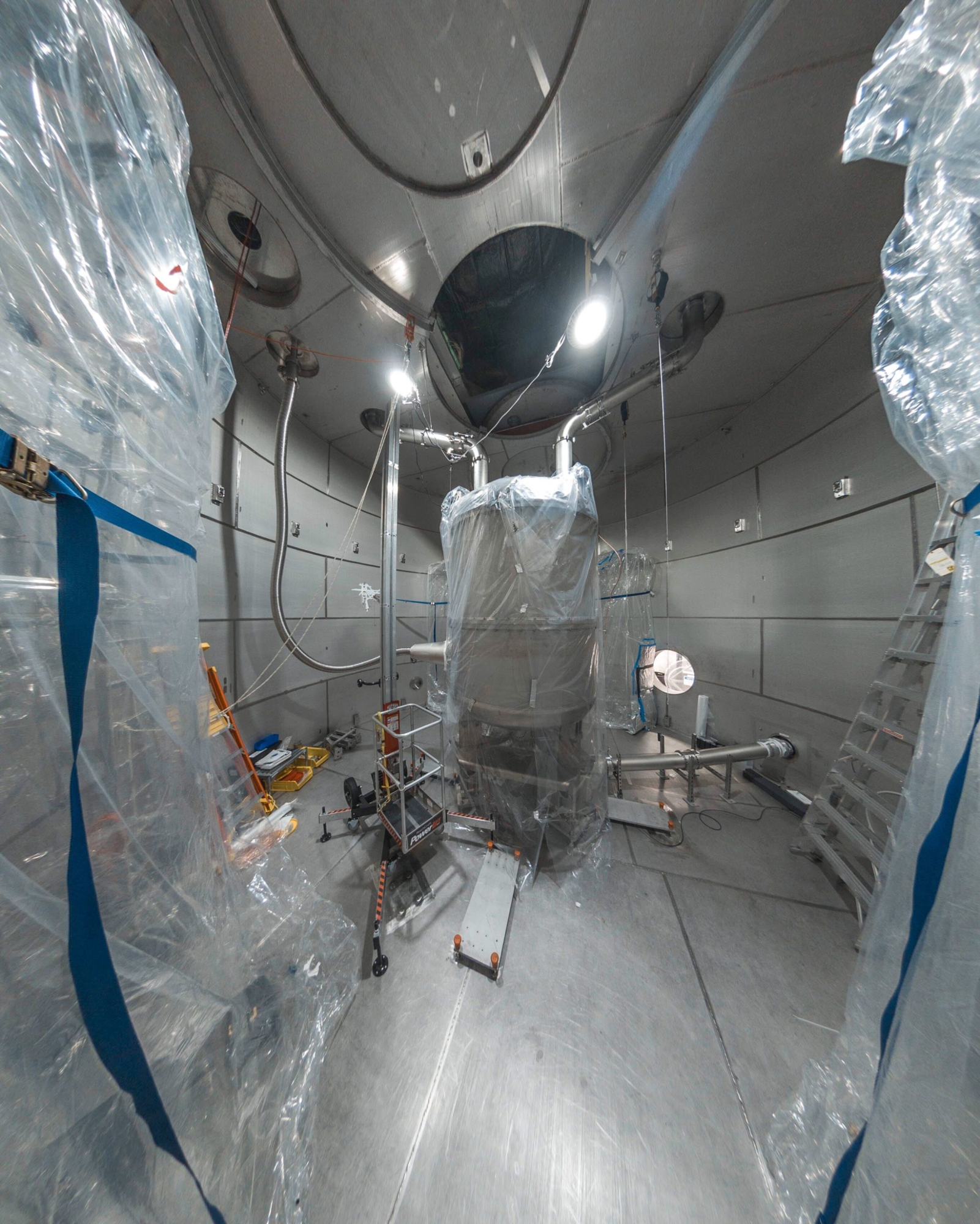Oct 28 2020
Teams working on the largest experiment in the United States have concluded a significant milestone on September 2020. The experiment was specifically developed to directly identify dark matter.
 LZ’s central detector, pictured here during assembly, is located inside a large water tank on the 4850 Level of Sanford Lab. LZ will search for theorized dark matter particles known as WIMPs. Image Credit: Nick Hubbard/Sanford Lab.
LZ’s central detector, pictured here during assembly, is located inside a large water tank on the 4850 Level of Sanford Lab. LZ will search for theorized dark matter particles known as WIMPs. Image Credit: Nick Hubbard/Sanford Lab.
After experiencing some delays owing to global pandemic precautions, the crews are now focusing on startup.
On September 21st, 2020, officials from the U.S. Department of Energy (DOE) had formally signed off on project completion for an ultrasensitive experiment called LUX-ZEPLIN, or LZ.
The experiment will utilize 10 metric tons of liquid xenon to search for signals of interactions with theorized dark matter particles known as weakly interacting massive particles, or WIMPs for short. The DOE’s project completion milestone is referred to as Critical Decision 4, or CD-4.
Dark matter constitutes an estimated 85% of all matter found in the universe. While individuals are aware of the existence of dark matter in the universe because of its observed gravitational impacts on normal matter, they still do not yet know what exactly it is.
LZ was developed to identify the two flashes of light that appear when an interaction takes place between a WIMP and the nucleus of a xenon atom.
“We are completing commissioning of the detector—the testing phase—and will be looking at LZ data next year,” stated Simon Fiorucci, LZ operations manager and also a physicist from the DOE’s Lawrence Berkeley National Laboratory (Berkeley Lab), which happens to be the lead institution for the LZ partnership.
LZ has been installed almost a mile under the ground at the Sanford Underground Research Facility (Sanford Lab) based in Lead, South Dakota. LZ’s depth offers natural protection against the continuous shower of cosmic rays that occur at the surface of the Earth. These cosmic rays are a source of background particle “noise” that may overpower the WIMP interaction signals researchers are looking for.
Moreover, LZ was created from components that were individually chosen and validated to be low in naturally occurring radiation that might also complicate the quest.
The entire Sanford Lab team congratulates the LZ Collaboration in reaching this major milestone. The LZ team has been a wonderful partner and we’re proud to host them at Sanford Lab. We’re looking forward to LZ data collection next year.
Mike Headley, Executive Director, Sanford Underground Research Facility
In view of the response to the COVID-19 pandemic, Sanford Lab had cut down its operations to only those that were believed to be important on March 25th, 2020. But on May 6th, 2020, the site started a transition back toward increased operations.
Many other institutions, including Berkeley Lab, in the LZ partnership, had also decreased their operations in response to the COVID-19 pandemic. Fortunately, Sanford Lab and LZ project workers were able to continue the work rapidly, noted Fiorucci.
Fiorucci further noted that xenon-purifying activities had been briefly delayed at the SLAC National Accelerator Laboratory, because of COVID-19-related reductions. Xenon, which is purified at the SLAC National Accelerator Laboratory, will be delivered to Sanford Lab and transformed into liquid xenon for the LZ experiment.
We’ve made decent progress despite all of these complications. We’d managed to maintain a workforce at Sanford Lab and at SLAC, and to keep things going at least at 80 percent speed. By June we were back at nominal speed, and have been back in that mode since.
Simon Fiorucci, Physicist, Lawrence Berkeley National Laboratory, U.S. Department of Energy
But despite these measures, COVID-19 risks continue to persist, and Fiorucci observed that employees continue to conform to safety procedures to decrease these risks.
At the time of this commissioning phase, there were around 15 to 20 LZ workers, who were divided into two shifts at Sanford Lab, added Fiorucci, and he anticipates that this level of staffing will hold through the year-end.
Now that CD-4 has been realized, it is interesting to have the finish line in sight, added Fiorucci.
We are getting a lot less engineering—and a lot more science—in the mix. It’s certainly exciting and thrilling.
Simon Fiorucci, Physicist, Lawrence Berkeley National Laboratory, U.S. Department of Energy
Fiorucci also observed that members of the collaboration have been in this position in the past: LUX experiment—the predecessor of LZ—was also set up and operated in the same underground research cavern at Sanford Lab.
However, this time it is different.
“We’ve certainly done this before, but never at this scale,” Fiorucci added.
While LUX utilized around one-third of a metric ton of liquid xenon, LZ will have 10 metric tons of liquid xenon and will be around 100 times more responsive to the interactions of dark matter particles.
“We are going into the unknown now,” Fiorucci concluded.